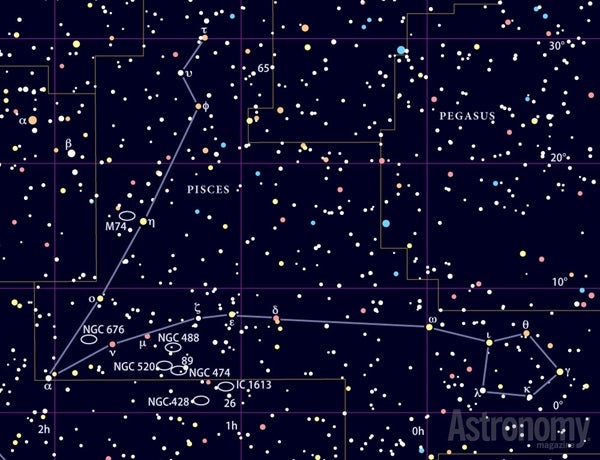Targets for November 5–12, 2015
Small telescope: Open clusters NGC 381 and NGC 436 in Cassiopeia
Large telescope: Spiral galaxy NGC 520
Large telescope: The Sculptor Dwarf
The Queen’s clusters
This week’s small-telescope targets are two open clusters in the constellation Cassiopeia the Queen. The first is NGC 381.
You’ll find this magnitude 9.3 object 1.7° east-northeast of magnitude 2.5 Tsih (Gamma [γ] Cassiopeiae). Look sharp because it measures only 7′ across.
At low power through a 4-inch telescope, note how well the cluster blends into the rich background. Crank the magnification to 150x, however, and you’ll see an even distribution of some three dozen stars.
The second cluster, NGC 436, appears brighter but smaller. It shines at magnitude 8.8 and measures 5′ across. You can find it 1.9° southwest of magnitude 2.7 Ruchbah (Delta [δ] Cassiopeiae). Actually, however, you might find it easier to locate the bright Owl Cluster (NGC 457) and just move 0.7° northwest.
NGC 436 is a sparse cluster with two distinct brightness classes. The brighter stars form a V shape whose point faces roughly eastward. The fainter stars create a background glow through small telescopes, but resolve well through large ones.
Two for the price of one
This week’s first large-scope object is an odd duck. Although its designation is NGC 520, this object actually is a pair of interacting galaxies in Pisces that astronomers cataloged as a single object. Even a small scope will show its unusual shape.
To find it, look 4.5° west-southwest of magnitude 4.4 Nu (ν) Piscium. NGC 520 glows softly at magnitude 11.4 and measures 4.6′ by 1.9′.
Through a 6-inch telescope at low power, you’ll think you’re looking at an edge-on spiral. Crank the magnification up to 150x, however, and the sharp northwest edge will pop into view. Through larger instruments, a dark lane that divides the two galaxies becomes visible.
Dwarf, not midget
This week’s second large-telescope target is a dwarf spheroidal galaxy in the constellation Sculptor called, appropriately enough, the Sculptor Dwarf.
To find it, look 2.3° south-southwest of magnitude 5.5 Sigma (σ) Sculptoris. Well, that’s where to point your telescope, at least. Although this object claims a visual magnitude of 8.8, it measures a whopping 1.1° by 0.8°.
That means the Sculptor Dwarf covers more area than four Full Moons, so its surface brightness is incredibly low. Eagle-eyed observers have spotted it through 6-inch telescopes, but your best bet is to head to an ultra-dark site and insert your lowest-power eyepiece into at least a 12-inch scope. Then, ever-so-slowly scan the area. What you’re looking for is a slight brightening of the background glow.
The Sculptor Dwarf was the first dwarf spheroidal galaxy discovered. In 1937, American astronomer Harlow Shapley found it on a photographic plate.
And, just in case you’re wondering, the main difference between this type of galaxy and a dwarf elliptical is that a dwarf spheroidal galaxy has an even lower surface brightness.
Expand your observing at Astronomy.com
StarDome
Check out Astronomy.com’s interactive StarDome to see an accurate map of your sky. This tool will help you locate this week’s targets.
The Sky this Week
Get a daily digest of celestial events coming soon to a sky near you.
Observing Basics
Find more guidance from Senior Editor Michael E. Bakich with his Observing Basics video series.











